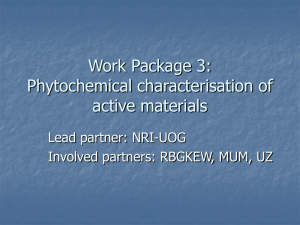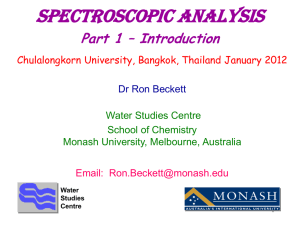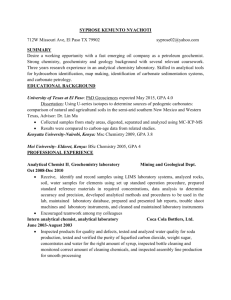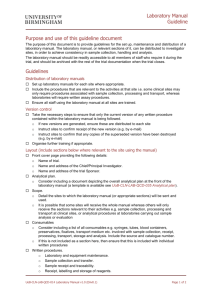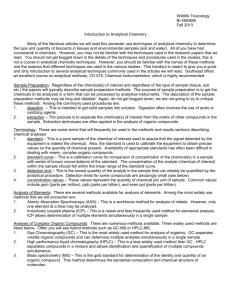ionic analytical
advertisement
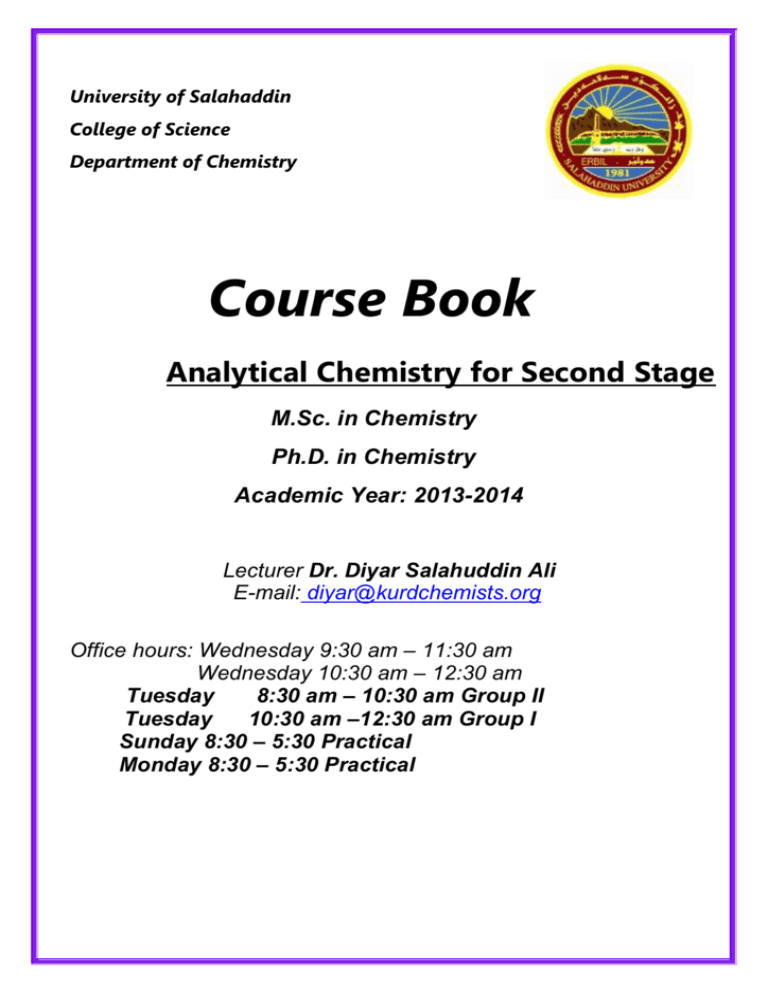
University of Salahaddin College of Science Department of Chemistry Course Book Analytical Chemistry for Second Stage M.Sc. in Chemistry Ph.D. in Chemistry Academic Year: 2013-2014 Lecturer Dr. Diyar Salahuddin Ali E-mail: diyar@kurdchemists.org Office hours: Wednesday 9:30 am – 11:30 am Wednesday 10:30 am – 12:30 am Tuesday 8:30 am – 10:30 am Group II Tuesday 10:30 am –12:30 am Group I Sunday 8:30 – 5:30 Practical Monday 8:30 – 5:30 Practical Course Objective First Semester The following objectives should be achieved by the student during first course. All of the objectives are preceded by the phrase, "The student should be able to:" 1. 2. 3. 4. 5. 6. 7. 8. 9. Introduction to Analytical Chemistry as general. Analytical Chemistry Classification Simple information about Qualitative Analysis Quantitative Analysis Gravimetric Methods of Analysis Types of Gravimetric Methods Precipitation Gravimetry Mechanism of Precipitate Formation Chemical formula for precipitate and the calculations in the quantitative gravimetric analysis 10. Factors which affected of the solubility precipitate 11. Common ion Effect…. 12. Ionic Strength Effect…… 13. Activity and activity coefficient…… 14. pH effect…… 15. Mechanism for Precipitation 16. Factors Affecting Particle Size 17. Techniques to minimize Q_S S 18. Controlling Precipitation 19. Gravimetric Overview First course covered all gravimetric analysis, the purpose for that for takes the gravimetric analysis in the first semester as continues for Sample Analysis, as we know all sample analysis begin with knowing which is include? (Qualitative), then we must try to calculate it (Quantitative) after that we must try to separate between them, finally if we can't do that by chemical method we changed to Instrumental Analysis. Course Objective Second Semester The following objectives should be achieved by the student during second course. All of the objectives are preceded by the phrase, "The student should be able to:" 1. History of Statistical Chemistry 2. Terminology of Statistical Chemistry 3. Subsection of the analytical approach to problem solving 4. Classifying Analytical Techniques 5. The Assessment of Analytical Data 6. Gaussian distribution 7. The Mean, Median and Mode 8. Deviation 9. Selecting an Analytical Method 10. Numerical Criteria for Selecting an Analytical Method 11. Precision 12. Methods for expressing precision 13. Absolute methods for expressing precision 14. Relative methods for expressing precision 15. Significant Figures in Mean and Standard Deviation 16. The Nature and Origin of Errors 17. Calibration 18. Standardization of Analytical Methods 19. Calibration Curve 20. Sample Preparation 21. Standard addition 22. Sensitivity 23. Sensitivity 24. Reproducibility 25. Limit of quantification 26. Limits of Detection Grading The students are required to do at least two closed exam at the mid of eachsemester besides other assignments and each student must prepare fullreport at the end of the year. All exams have 20 marks, full report has 2 marks, the classroom activities count 2 marks and 1 mark for attendance. So that the final gradewill be based upon the following criteria: Mid- semester exam: 20% Classroom participation and assignments 5% Practical Course 15% Final Exam: 60% which include 40% for theoretical and 20% for practical. Course Material Required books for the first semester: 1- Analytical Chemistry by Gary D. Christain, 5th edition 2- Chemical Separation principles, Techniques and Experiments by Clifton E. Meloan 3- Fundamentals of Analytical Chemistry by Douglas A. Skoog 4- Quantitative Chemical Analysis by Kolthofe- Sanell 5- Analytical Chemistry Principles by John H. Kennedy 6- Modern Analytical Chemistry by David Harvey Required books for the second semester: 1. Analytical Chemistry, Theoretical and Metrological Fundamentals K. Danzer 2. Principles and Practice of Analytical Chemistry, F.W. Fifield 3. Validation and Qualification in Analytical Laboratories, Ludwig Huber Course Program (Gravimetric Analysis) Week 1: 1. 2. 3. 4. 5. 6. Curriculum of Analytical Chemistry for Second Stage Chemistry How students download all lectures from the IKCS website Meaning of Analytical Chemistry Classification of Analytical Chemistry Types of Analysis Electrolytes, acids and bases Week 2: 1. 2. 3. 4. 5. Quantitative Analysis Chemical Methods Gravimetric Methods of Analysis Types of Gravimetric Analysis Terms and Examples Week 3: 1. 2. 3. 4. 5. Types of Gravimetric Analysis (Explanation) Precipitation Gravimetry Important Attributes for Precipitation Gravimetric Solubility Considerations Avoiding Impurities Week 4: 1. 2. 3. 4. 5. Mechanism of Precipitate Formation Induction Period Sample Classification Conditions Required for Prepare any Sample to Gravimetric Analysis Precipitate and weighing form properties which are used in Quantitative gravimetric analysis 6. The advantageous and disadvantageous for organic and inorganic precipitant. Week 5: 1. Chemical formula for precipitate and the calculations in the quantitative gravimetric analysis 2. Examples Week 6: 1. 2. 3. 4. Factors which affected of the solubility precipitate Common Ion Effect…. Example for Common Ion Effect Ionic Strength Effect Week 7: First Examination Week 8: 1. Examples of Ionic Strength Effect 2. Activity and activity coefficient…… 3. Examples Activity and activity coefficient…… Week 9: 1. pH Effect 2. Examples of pH Effect Week 10: 1. Mechanism for Precipitation 2. Factors Affecting Particle Size 3. Techniques to minimize Week 11: Second Examination Week 12: 1. Induction Period 2. Example Week 13: Gravimetric Theory for Precipitation Week 14: 1. Conditions need for Analytical Precipitation 2. Gravimetric Overview Week 15: Factors which affecting on the Precipitation Process Course Program (Statistical Chemistry) Week 1: 1. History of Statistical Chemistry 2. Terminology 3. Example Week 2: 1. 2. 3. 4. Subsection of the analytical approach to problem solving Classifying Analytical Techniques Analytical Techniques The Assessment of Analytical Data Week 3: 1. 2. 3. 4. 5. 6. 7. Definitions and Basic Concepts Gaussian Distribution Mean Median Mode Deviation Exercise Week 4: 1. 2. 3. 4. 5. 6. 7. Selecting an Analytical Method Numerical Criteria for Selecting an Analytical Method Precision Methods for expressing precision Absolute Method for Precision Relative Methods for Precision Absolute Standard deviation Week 5: 1. 2. 3. 4. 5. 6. Normal Distribution Relative Standard Deviation Coefficient of Variation Variance Spread Standard Deviation of the Mean Week 6: 1. The Nature and Origin of Errors 2. Types of Error 3. Determinate Error Week 7: Third Examination Week 8: 1. 2. 3. 4. 5. Determinate of method errors Indeterminate Error Accuracy and Trueness Accuracy Calculations Model of Error Week 9: 1. 2. 3. 4. 5. Probability of Obtaining a Specific Measured Value Frequency of Measuring Specific Values Accuracy, Precision, Resolution Quantifying Accuracy, Precision, Resolution Precision versus Accuracy Week 10: 1. 2. 3. 4. 5. 6. 7. 8. Calibration Standardization of Analytical Methods Calibration Curve Typical Calibration Curve Calibration Process Characteristics Objective Summary of Process Week 11: Final Examination Week 12: 1. 2. 3. 4. Obtain Calibration Curve Sample Preparation Standardization of Analytical Methods Standard Addition Week 13: 1. Sensitivity 2. Calibration Sensitivity 3. Analytical Sensitivity Week 14: 1. 2. 3. 4. 5. 6. Reproducibility Detection Limit Signal Detection Limit Concentration Detection Limit Limit of quantification Selectivity Week 15: Examples and solving steps by steps
